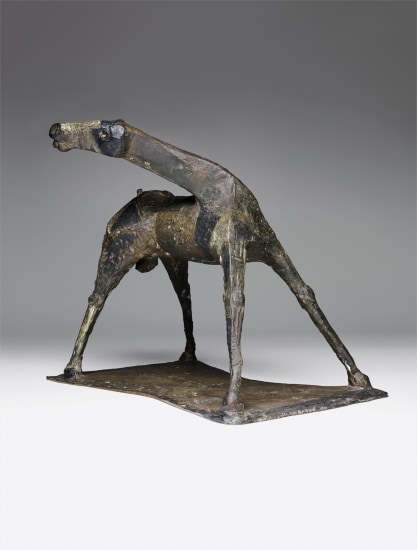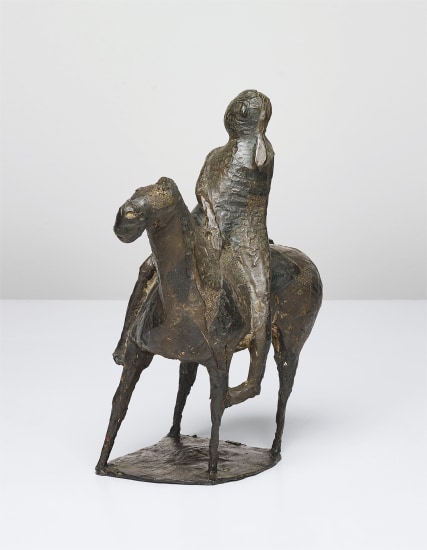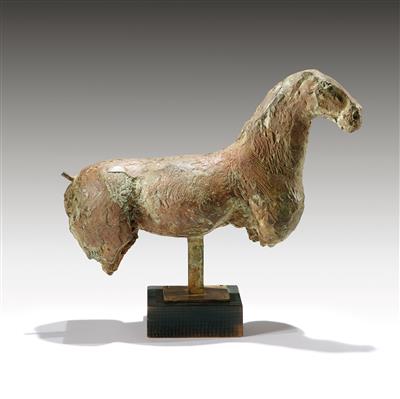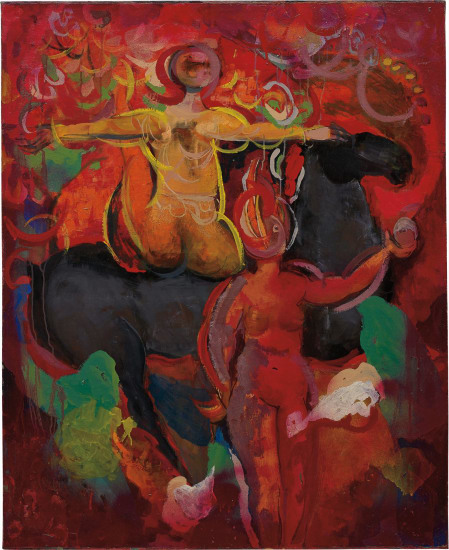MARINO MARINI (1901-1980)Cavalli e cavalieri signed and dated 'Marino 1970' (lower right) oil on paper 39.3 x 51.1cm (15 1/2 x 20 1/8in). Executed in 1970 FootnotesThe authenticity of this work has been confirmed by the Fondazione Marino Marini Provenance Dominion Gallery, Montreal, no. B6324 (possibly acquired directly from the artist in the 1980s). Private collection, Switzerland & UK (acquired from the above circa 1997). Exhibited Toronto, Istituto Italiano di Cultura, Marino Marini Sculptures, paintings, drawings, 27 May – 11 July 1998. A cavalry rider of the avant-garde, Marino Marini forged a valiant artistic pathway that was in sync with the strident drumbeats of Modernity. Utilising the horse and rider as a lifelong leitmotif, Marini conveyed an exhaustive breadth of drama and emotion, scaling the divide between primeval furore and contemporary anxiety. By enunciating this classical trope with the fragmented language of his own zeitgeist, Marini engendered deep and dynamic meditations on the state of the world and man's relationship with it. Completed ten years before his passing at the age of 79, Cavalli e cavalieri represents a chapter in which Marini's horses and riders are reduced to ideas or memories. The present work therefore embodies the distilled values of a master artist who had reached the apex of his creative vision. Marini grew up in the bucolic environs of Tuscany, enveloped in sun-drenched natural landscapes dotted with the emotive frescoes of Giotto and Masaccio. He strongly identified as a descendent of the Etruscans – a tendency which manifested in the ancient and mythical qualities of his art. Marini learned the language and imagery of the early Renaissance and the international Gothic style whilst enrolled at the Accademia di Belli Arti in Florence from 1917, thence developing a personal connection with Northern European sculpture and ancient cave paintings. His travels placed him at the centre of the European avant-garde: in Paris he associated with Pablo Picasso and Giorgio de Chirico and then in Switzerland he befriended Germaine Richier and Alberto Giacometti The creative discourse between Marini and Giacometti resounded in their shared preferences for attenuated forms, expressive textures and rigid abstraction. After starring in the Twentieth-Century Italian Art exhibition at the Museum of Modern Art in New York (1949), Marini became ingratiated with an exciting new generation of post-war artists, among them Lyonel Feininger Max Beckmann and Alexander Calder The horse and rider first appeared in Marini's work in 1936, after he visited Der Bamberger Reiter, an early thirteenth century equestrian sculpture at the Cathedral of Bamberg in Germany. In Marini's first iterations of the subject, his riders and their steeds possess elongated physiques, their poses calm and formal. By 1940, they evolve into more squat, simplified, archaic forms. After the Second World War, the horses often have their mouths open in silent screams, their ears pinned back in ecstasy or anguish. Indeed, Marini had witnessed true atrocities under the Italian fascist regime, including watching terrified peasants fleeing from armed forces on horseback. In ensuing years, Marini's riders appear to be dislocated from their mounts and focused on their inner human turmoil, reflecting a society bent by trauma, grief and apathy. By 1970 – and in the present work – the equestrian motif had been reduced into a kind of patterned obscurity, one that favoured impulse and impression over object and circumstance. This chronological disintegration was for Marini an extended metaphor for mankind's expulsion from earthly paradise into the cruel reality of war. In Cavalli e cavalieri, Marini creates mysteries that are just as vivid as his colours and forms. Bright, full-bodied black and blue oil paints coalesce into evocations rather than descriptions of the horses and riders, omitting any possible whispers of individualisation. Marini's
MARINO MARINI (1901-1980)Cavalli e cavalieri signed and dated 'Marino 1970' (lower right) oil on paper 39.3 x 51.1cm (15 1/2 x 20 1/8in). Executed in 1970 FootnotesThe authenticity of this work has been confirmed by the Fondazione Marino Marini Provenance Dominion Gallery, Montreal, no. B6324 (possibly acquired directly from the artist in the 1980s). Private collection, Switzerland & UK (acquired from the above circa 1997). Exhibited Toronto, Istituto Italiano di Cultura, Marino Marini Sculptures, paintings, drawings, 27 May – 11 July 1998. A cavalry rider of the avant-garde, Marino Marini forged a valiant artistic pathway that was in sync with the strident drumbeats of Modernity. Utilising the horse and rider as a lifelong leitmotif, Marini conveyed an exhaustive breadth of drama and emotion, scaling the divide between primeval furore and contemporary anxiety. By enunciating this classical trope with the fragmented language of his own zeitgeist, Marini engendered deep and dynamic meditations on the state of the world and man's relationship with it. Completed ten years before his passing at the age of 79, Cavalli e cavalieri represents a chapter in which Marini's horses and riders are reduced to ideas or memories. The present work therefore embodies the distilled values of a master artist who had reached the apex of his creative vision. Marini grew up in the bucolic environs of Tuscany, enveloped in sun-drenched natural landscapes dotted with the emotive frescoes of Giotto and Masaccio. He strongly identified as a descendent of the Etruscans – a tendency which manifested in the ancient and mythical qualities of his art. Marini learned the language and imagery of the early Renaissance and the international Gothic style whilst enrolled at the Accademia di Belli Arti in Florence from 1917, thence developing a personal connection with Northern European sculpture and ancient cave paintings. His travels placed him at the centre of the European avant-garde: in Paris he associated with Pablo Picasso and Giorgio de Chirico and then in Switzerland he befriended Germaine Richier and Alberto Giacometti The creative discourse between Marini and Giacometti resounded in their shared preferences for attenuated forms, expressive textures and rigid abstraction. After starring in the Twentieth-Century Italian Art exhibition at the Museum of Modern Art in New York (1949), Marini became ingratiated with an exciting new generation of post-war artists, among them Lyonel Feininger Max Beckmann and Alexander Calder The horse and rider first appeared in Marini's work in 1936, after he visited Der Bamberger Reiter, an early thirteenth century equestrian sculpture at the Cathedral of Bamberg in Germany. In Marini's first iterations of the subject, his riders and their steeds possess elongated physiques, their poses calm and formal. By 1940, they evolve into more squat, simplified, archaic forms. After the Second World War, the horses often have their mouths open in silent screams, their ears pinned back in ecstasy or anguish. Indeed, Marini had witnessed true atrocities under the Italian fascist regime, including watching terrified peasants fleeing from armed forces on horseback. In ensuing years, Marini's riders appear to be dislocated from their mounts and focused on their inner human turmoil, reflecting a society bent by trauma, grief and apathy. By 1970 – and in the present work – the equestrian motif had been reduced into a kind of patterned obscurity, one that favoured impulse and impression over object and circumstance. This chronological disintegration was for Marini an extended metaphor for mankind's expulsion from earthly paradise into the cruel reality of war. In Cavalli e cavalieri, Marini creates mysteries that are just as vivid as his colours and forms. Bright, full-bodied black and blue oil paints coalesce into evocations rather than descriptions of the horses and riders, omitting any possible whispers of individualisation. Marini's






.jpg)

.jpg)

.jpg)
.jpg)


Testen Sie LotSearch und seine Premium-Features 7 Tage - ohne Kosten!
Lassen Sie sich automatisch über neue Objekte in kommenden Auktionen benachrichtigen.
Suchauftrag anlegen